Journal of the NACAA
ISSN 2158-9429
Volume 12, Issue 1 - June, 2019
Soil Moisture Meters Influence Landscape Water Use
- Muntz, H. E., Extension Assistant Professor, Utah State University
Walker, A., Extension Urban Director, Utah State University
Gunnell, J., Extension Associate Professor, Utah State University
ABSTRACT
In response to drought conditions, urban population growth, and dwindling water supplies in Utah, Utah State University (USU) Extension implemented a study using soil moisture meters. USU Extension distributed free soil moisture meters to residents across the state in order to help them irrigate their landscapes accurately based on plant needs and site-specific conditions. Soil moisture meters were distributed during fairs, festivals, classes and other summer events in eight counties. Each meter was packaged with an instructional tag, which included a watering guideline and a link to online resources for water conservation. Researchers used online surveys to determine whether the meters affected irrigation habits of the participants. According to survey results, soil moisture meters can assist residents in effective water use in the landscape. Furthermore, 72% of participants reduced their irrigation after using their meter.
INTRODUCTION
Landscape irrigation has been a large focus for research in response to drought conditions, urban population growth and decreasing water supply throughout the United States (St. Hilaire et al., 2008; Kopp, 2007; McCammon, 2009; Seymour, 2009). Urban landscape irrigation varies from 40% to 70% of household water use across the country, depending on region and other factors (St. Hilaire et al., 2008). This data in Utah mirrors that of other states (Haley et al., 2007; St. Hilaire et al., 2008). In arid states, landscape water use tends to increase during drought years (Balling and Gober, 2006). Particularly in Utah, landscape irrigation accounts for 50-75% of annual municipal water use (Glenn, 2010).
Proper irrigation scheduling according to site-specific soil conditions and plant needs can greatly reduce excess water use. For instance, education initiatives in Utah, such as on-site irrigation system evaluations, have positively influenced homeowner irrigation behavior and water conservation in the residential landscape (Muntz and Kopp, 2019, in review). USU Extension faculty diagnose numerous plant problems that are due to watering issues. Therefore, addressing plant water needs requires education.
The goal of this program was to help Utah residents make irrigation decisions based on actual soil moisture readings. Soil moisture meters can help homeowners realize when irrigation is or is not necessary, thus aiding in educated irrigation practice for healthy landscapes and water conservation. Soil moisture meters are inexpensive tools used to read soil moisture levels and their information can be used to time irrigation events accurately.
METHODS
Soil moisture meters were ordered in bulk through Amazon.com at an average price of $6.30/piece. Two types of soil moisture meters were ordered during the program. The first meters ordered were the “3 in 1 Soil Tester” by niceEshop, which includes 2 probes that read soil moisture, soil pH, and a light sensor. The second order of meters were the Amrka Soil Moisture Tester, which includes only one probe for reading soil moisture. Each meter was packaged with a tag that included instructions for meter use, a general watering guideline designed by USU Extension and online resources for water conservation (Figure 1). Meter use instructions included:
- Depth and location of meter probe for best reading
- How to interpret meter reading
- Meter care and maintenance of probe (i.e. removal and cleaning between readings)
Meters were distributed to collaborating Extension Offices in eight counties throughout Utah. In 2017 and 2018, meters were given to the public during fairs, farmers markets, Extension horticulture events, and plant diagnostic clinics during high irrigation months (May through September). Public participants were asked to provide their email address and agree to respond to follow-up surveys before receiving their moisture meter. Two separate online surveys were developed for evaluating the effect of using soil moisture meters: a simple retrospective “post-then-pre” survey for the public participants and a more in-depth pre-post data sheet for the Extension Master Gardener participants.
Master Gardener volunteers helped promote the study. Facilities and booth space were donated during summer fairs, farmers markets and other events throughout the state. Master Gardeners were introduced to the program during their training lectures and given the opportunity to participate and provide more in-depth data.

Figure 1: Soil moisture meter tag.
RESULTS
During the summers of 2017 and 2018, 1,279 soil moisture meters were distributed, with a total of 964 public participants and 315 Master Gardener participants. A follow-up online survey was emailed to the participants within 6 weeks and received a 40% response rate. Lawns and vegetable gardens are the two landscape areas that were tested most frequently by both public and Master Gardener participants (Table 1). Within the surveys, Master Gardeners were only given the six landscape options for testing soil while other public participants were given the additional option for “Other” (i.e. potted plants, indoor plants, etc.).
Table 1. Percent frequency of landscape area tested. Participants utilized their soil moisture meters in multiple landscape areas.
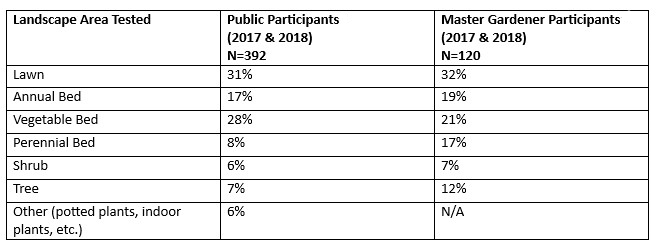
Out of our public participants, 42% indicated that the moisture of their lawn was wetter than they expected and 20% indicated that their vegetable garden was wetter than they expected. Forty-eight percent of public respondents visited slowtheflow.org and 72% reduced their landscape irrigation after using their soil moisture meter (Table 2). The majority of public participants who did reduce watering delayed watering sporadically and 23% reduced their watering by one less day a week (Table 3).
Table 2. Public participant response to questions.
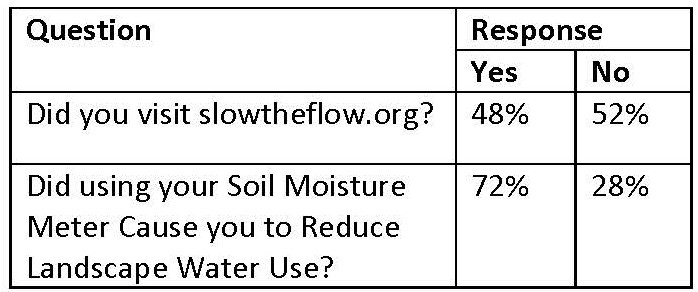
Table 3. Changes in irrigation by public participants who reduced landscape water use. N refers to total number of participant respondents who reduced irrigation after using the soil moisture meter.
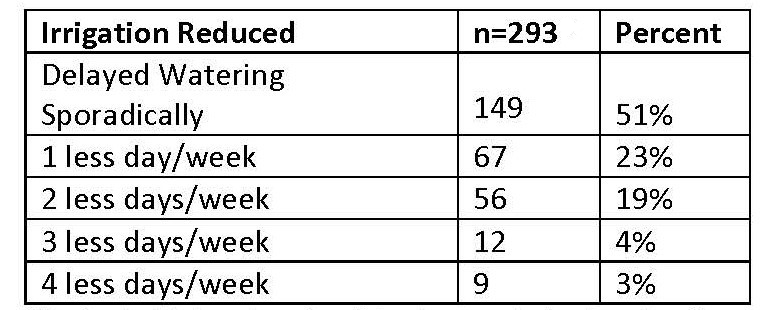
Master Gardener participants recorded their watering schedules prior to and after using their meter. Prior to using the meter, 18% of Extension Master Gardener participants watered their lawns 7 days a week, 19% watered 4 days a week and 28% watered 3 days a week. After using the soil moisture meter, only 5% of Master Gardener participants continued watering 7 days a week, and more Master Gardeners were watering only one, two or three days a week; 13%, 20%, and 40% respectively (Figure 2). Results were similar for irrigation schedules in Vegetable Gardens (Figure 3).
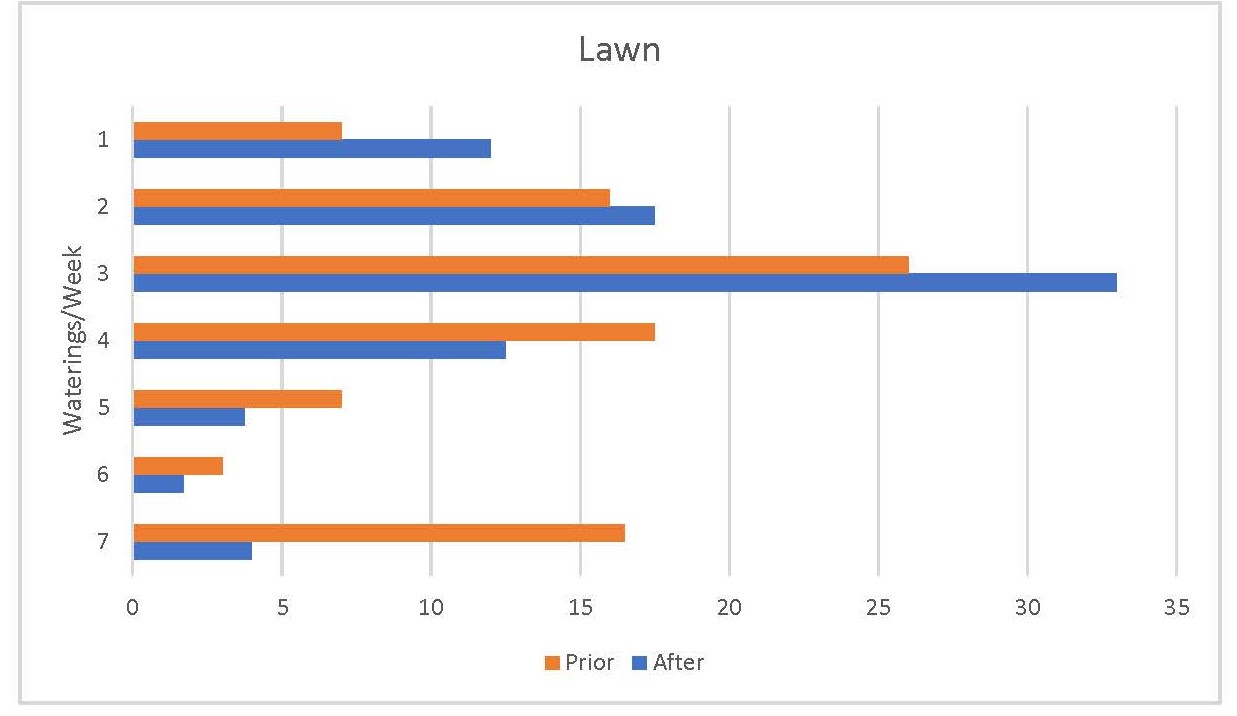
Figure 2. Master Gardener participant lawn irrigation schedule prior to and after using the soil moisture meter.
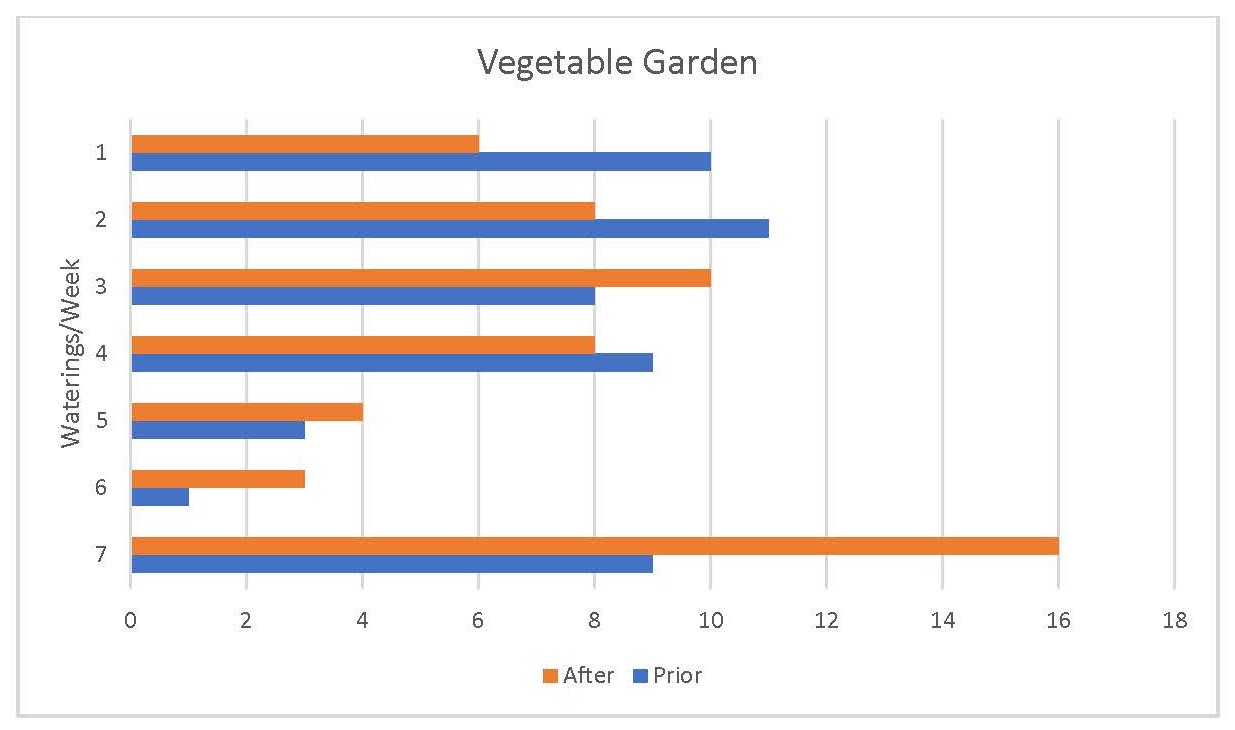
Figure 3: Master Gardener participant vegetable garden irrigation schedule prior to and after using the soil moisture meter.
According to survey results, 30% of Master Gardeners were watering their vegetable gardens 7 days a week and 18% were watering 3 days a week prior to using the soil moisture meter. After using the meter, only 18% of Master Gardeners were watering their vegetable garden every day and the majority were watering once or twice a week (41%).
Twenty-eight percent of the participants did not reduce their water use and we addressed that within the survey by asking the follow-up question: “why didn’t your soil moisture meter cause you to delay or reduce your water use?” Some of the responses included:
- “I only irrigate every 8 days”
- “Plants were getting appropriate amount of water”
- “The meter was always on the edge of DRY not quite moist”
- “My lawn was dryer than I expected”
- “I just put in new sod”
DISCUSSION AND CONCLUSION
Overall, the program results indicate that soil moisture meters prove to be helpful to homeowners in regulating irrigation habits. The participants in the study included a range of first time gardeners, homeowners struggling with their lawns and landscape, experienced gardeners and Master Gardener volunteers. Master Gardener participants are more likely to be conscious about water use as well as have a better understanding of plant water requirements than the general public. However, survey results indicate a reduction in weekly irrigation events by the Master Gardeners after using their soil moisture meter.
The 3 in 1 Soil Tester was very popular because participants were able to test both soil pH and soil moisture. However, there was some concern that participants may have been reading pH rather than moisture if the dial was not placed in the correct position, i.e. if the dial was in the pH position while the participants were testing moisture, they would have an incorrect interpretation. Due to several calls from participants, we learned it would be best to provide a simpler meter with only one probe (the Amrka Soil Moisture Tester) in order to avoid potential misinterpretations of readings. Though these were less popular, it eliminated potential misperception in soil moisture readings.
Providing Utah residents with free soil moisture meters encouraged positive change in landscape irrigation behavior. Meters allowed participants to measure soil moisture and decide when it was necessary to water, and therefore reduced the numbers of irrigations throughout the season. Along with utilizing online resources and following general irrigation guidelines, soil moisture meters helped participants determine water needs for their specific site and plant type. This is a hands-on and simple way for participants to visualize irrigation needs, and adjust their watering accordingly. Information gathered by Master Gardener volunteers may prove to be useful in creating potential irrigation guidelines for homeowners under specific site conditions and plant materials.
REFERENCES
Balling, R.C. Jr., and Gober, P. (2007). Climate variability and residential water use in the city of Phoenix, Arizona. Journal of Applied Meteorology and Climatology 46(7):1130-1137. https://journals.ametsoc.org/doi/pdf/10.1175/JAM2518.1
Glenn, D.T. (2010). Residential landscape water check programs: Exploring a conservation tool (master’s thesis). Available from Digital Commons All Graduate Theses and Dissertations. Utah State University (836).
Haley, M.B., Dukes, M.D., and Miller, G.L. (2007). Residential irrigation water use in central Florida. Journal of Irrigation & Drainage Engineering 133(5):427–434. https://doi.org/10.1061/(ASCE)0733-9437(2007)133:5(427).
Kopp, K. L., Cerny-Koenig, T., and Lopez, R. (2007). Educating large landscape water users. Journal of Extension 45(1). Retrieved from: https://www.joe.org/joe/2007february/iw6.php
McCammon, T.A., Marquart-Pyatt, S.T., and Kopp, K.L. (2009). Water-conserving landscapes: an evaluation of homeowner preference. Journal of Extension 47(2). Retrieved from: https://joe.org/joe/2009april/rb5.php
Muntz, H., and Kopp, K. (2019). Influencing water consumption through the water check program. Journal of Extension (in review).
Seymour, R. M., and Bauske, E. M. (2009). Implementing water conservation education for university campus facilities and grounds managers. Journal of Extension 47(4). Retrieved from: https://www.joe.org/joe/2009august/tt5.php
St. Hilaire, R., Arnold, M.A., Wilkerson, D.C., Devitt, D.A., Hurd, B.H., Lesikar, B.J., … Zoldoske, D.F. (2008). Efficient water use in residential urban landscapes. Journal of the American Society for Horticultural Science 43(7): 2081–2092. Retrieved from http://hortsci.ashspublications.org/content/43/7/2081.full.pdf.
